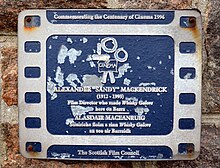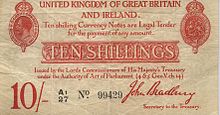Politician (ship)
|
||||||||||||||||||||||||
|
||||||||||||||||||||||||
|
||||||||||||||||||||||||
|
||||||||||||||||||||||||
The Politician was a British steam - cargo ship , which on 5 February 1941 the way to the United States in a storm off Eriskay , an island in the Outer Hebrides ran aground. The Politician became famous for the fact that a large part of its cargo, consisting of 264,000 bottles of Scottish single malt whiskey , was looted by the island's population . The event was conceived by Compton Mackenzie in his 1947 novel Whiskey galore! which in turn became the basis for two feature film comedies from 1949 and 2016 as well as a musical .
history
The ship was built under the name London Merchant for the shipping company Furness, Withy & Co. and used on the London - New York route. In 1935, after being bought by T. & J. Harrison , the ship was named Politician and now sailed to South Africa .
During the Second World War , the Politician left the port of Liverpool on February 4, 1941 to transport goods as part of a convoy to Kingston , Jamaica and New Orleans . The cargo consisted of cars, bicycles, cotton, tobacco, around £ 145,000 in banknotes and 28,000 boxes of various brands of Scottish whiskey. This came from two bombed out warehouses in Leith and Glasgow . Beaconsfield Worthington, the captain of the freighter, had set a course towards The Minch , a strait between the Isle of Skye and the Outer Hebrides, to join the convoy for the journey across the North Atlantic . However, shortly after sailing, a severe storm arose. On the morning of February 5, around 7:45 a.m. , the Politician ran aground on underwater rocks on the uninhabited little island of Calvay off the north side of Eriskay, flooding parts of the engine room and some holds and breaking the propeller shaft . As a result, the ship was unable to maneuver and released an SOS . The crew gave up the ship and were able to save themselves by boats to the island of Eriskay, where they reported to the residents of their unusual cargo.
charge
The cargo, consisting largely of luxury goods, was intended to be sold primarily in the USA in order to obtain the foreign exchange necessary for the war .
Banknotes
The Caribbean island of Jamaica was still a British crown colony at that time and served as a naval base. Great Britain was therefore also responsible for supplying the island with fresh money through the Crown Agents . For this reason there were eight boxes with a total of 290,000 blue 10 shilling bills (then £ 145,000, according to today's purchasing power several million) on board the Politician . After the sinking of the freighter, it was assumed that most of the banknotes had sunk with it or had become unusable due to leaking oil and salt water, but a rescue team reported on April 24, 1941 that banknotes had washed up on the island of Benbecula, about 40 km away and children played with it. An empty box of banknotes was discovered in May and the first notes that had clearly come into contact with water soon appeared in banks in Scotland and other parts of the UK. In 1958, Crown Agents reported that 211,267 of the 290,000 notes had been recovered. A further 2,329 shilling notes appeared at banks in Ireland, Jamaica, Malta, Switzerland and the USA. All inquiries into the whereabouts of the remaining 76,404 banknotes have remained unsuccessful to this day.
whiskey
Since the whiskey was destined for the US market, it had not been cleared . During the war, food was also rationed in the UK . The whiskey stocks on Eriskay were almost completely exhausted in early 1941.
Whereabouts of the whiskey
After the island's population (approx. 400 people in 1941) learned of the shipwrecked whiskey cargo, they immediately organized the " recovery " of the liquid cargo. Shortly afterwards, the first drove to the wreck in row boats. The "rescue" took place almost exclusively in the dark. The news of the shipwreck and the cargo spread like wildfire over the numerous islands of the Outer Hebrides, so that within a few days hundreds more people from other islands arrived on Eriskay to also get their share of the cargo. After around four weeks, the first officially commissioned rescue team finally arrived on the island.
Legal consequences
After the authorities learned of the looting of the uncleared alcohol, customs officials were dispatched to Eriskay to halt the activity, identify, arrest, prosecute looters and confiscate the illegally recovered whiskey . The islanders were not aware of any wrongdoing , as they were of the opinion that it was a question of flotsam from an abandoned ship and that the salvage of the cargo was lawful.
The customs officer and anti-alcoholic Charles McColl was entrusted with carrying out these tasks and, together with other officials and local police, he did everything in the coming weeks to track down all illegally appropriated bottles and punish the perpetrators. This resulted in the islanders hiding bottles all over the houses, stables, or anywhere on Eriskay. Between March and September 1941, with great difficulty, McColl succeeded in capturing some residents of the islands of Benbecula , South Uist and Eriskay in flagranti . These were initially only - in McColl's opinion - sentenced to small fines, but after McColl intervened again, some were sentenced to several months' imprisonment, which they served in Inverness and Peterhead .
According to McColl's own estimate, the islanders had managed to recover around 24,000 bottles. A second salvage company recovered 13,500 boxes. Since the authorities did not succeed in stopping the looting permanently, it was finally decided to blow up the Politician , which happened in October 1941. Since then, the main part of the wreck lies only five meters below the surface of the water and is extensively covered by sand and kelp .
Whiskey auctions
Before the ship was blown up, it was no longer possible to recover the other cargo. Since the downfall of the Politician , bottles have been washed ashore or found hidden on the island or in houses. The contents of some bottles were mixed with other types of whiskey to make " blended whiskey " and can still be bought today. Real bottles from the Politician appear very rarely in auctions . In 1987 a diver managed to recover eight bottles from the wreck. He auctioned them off at Christie's for £ 4,000 . On May 5, 2013, two of the eight bottles were auctioned for £ 12,050.
reception
book
The writer Compton Mackenzie , who lived on Barra , a neighboring island to Eriskay, in the 1930s - inspired by numerous conversations with locals - processed the story of the Politician's summons to write the successful novel Whiskey galore! (literally whiskey in abundance! or tons of whiskey! ), which was published in 1947 and experienced numerous new editions. The German translation appeared in 1966 under the title Das Whiskeyschiff .
Movies

Mackenzie's novel in turn formed the basis for the 1949 British comedy Whiskey Galore! which was filmed at Ealing Studios and directed by Alexander Mackendrick based on the script by Compton Mackenzie. The British premiere took place on June 16, 1949 in London. In the United States, the film was released in late December of that year. For the US audience, the film had the new title Tight Little Island ( tight , colloquial US English means something like tight , in the sense of blue or drunk ). The film was released in Germany under the title Rejoice in Life (later renamed Das Whiskey-Schiff ).
The film tells of the stranding of the freighter Cabinet Minister off the fictional Scottish island of Todday . The film was shot almost at the original location, namely on the neighboring island of Barra, only 15 km from Eriskay, as Eriskay was too small for the film team.
musical
2006 Whiskey Galore - a Musical! and premiered during the Edinburgh Festival Fringe . In 2009 numerous performances of a revised version followed at the Festival Theater in Pitlochry, Scotland .
poem
There was also a humorous, 31- stanza long, poem entitled The SS Politician , which Angus Mcintyre of Tobermory on the Isle of Mull is attributed. It is not known when the poem was written.
Music album
The Scottish anarcho-punk band Oi Polloi released an album in 2010 entitled SS Politician , the lyrics of which are partly written in Scottish Gaelic , which is still widely used in the Outer Hebrides today.
The events surrounding the Politician are still very present on Eriskay and Barra, there because of the shooting of the first film in 1949, and have become part of the collective memory . For example, in 2011 the 70th and February 2016 the 75th anniversary of the stranding were celebrated with various cultural events.
literature
- Roger Hutchinson: Polly. The True Story Behind Whiskey Galore. Mainstream Publishing, Edinburgh 1990, ISBN 1-85158-335-1 .
- Arthur Swinson: Scotch On The Rocks. The True Story Behind "Whiskey Galore". Peter Davies, London 1963.
Web links
- Technical data etc. of the SS Politician (stern) (+1941) on wrecksite.eu
- Online exhibition Whiskey for all! at the Merseyside Maritime Museum (in English)
- SS Politician: Whiskey galore off Eriskay In: The Scotsman, April 5, 2005
- Image of the Politican on isle-of-south-uist.co.uk
Individual evidence
- ↑ a b London Merchant SS (1923 ~ 1935) on wrecksite.eu
- ↑ a b c d SS Politician (stern) (+1941) on wrecksite.eu
- ↑ Information about T & J Harrison Ltd. on liverpoolmuseums.org.uk (pdf)
- ↑ Whiskey galore! , official website of the 2016 film
- ↑ Whiskey Galore a Musical! on whiskygaloreamusical.com.
- ↑ Photo of the Politician , please note copyrights.
- ↑ The last voyage on liverpoolmuseums.org.uk.
- ↑ a b Rare whiskey salvaged from SS Politician goes on show on The Scotsman on February 5, 2016.
- ↑ Banknotes galore after whiskey ship hits the rocks on: The Telegraph of January 26, 2001.
- ↑ a b c d Eyewitness report : Isle of Eriskay remembers looting of ship that inspired Whiskey Galore 75 years on : Scottish News from February 10, 2016.
- ↑ a b c Customs and Excise take a different view on liverpoolmuseums.org.uk.
- ↑ 70th anniversary of Whiskey Galore ship is marked on hebrides-news.com
- ↑ Entry on Politician in Canmore, the database of Historic Environment Scotland (English)
- ↑ Examples of Blended Whiskeys on scotchwhiskyauctions.com
- ^ Whiskey Galore and the SS Politician on isle-of-south-uist.co.uk.
- ↑ Bottles from wreck that inspired Whiskey Galore auctioned on BBC News on April 27, 2013
- ↑ Original Bottles From The SS Politician x 2 on scotchwhiskyauctions.com
- ↑ Whiskey Galore bottles fetch £ 12,050 on BBC News of May 6, 2013.
- ↑ Colin McArthur: Whiskey Galore! & The Maggie. A British Film Guide. Tauris, London 2003, ISBN 1-86064-633-6 , p. 81.
- ↑ Tight Little Island In: The New York Times Movie review, December 26, 1949
- ↑ Politician in the Internet Movie Database (English)
- ↑ Contents of Whiskey Galore - a Musical!
- ^ Text by The SS Politician
- ↑ 70th anniversary of Whiskey Galore ship is marked on hebrides-news.com from February 5, 2011 (shows the Politician with camouflage ).

